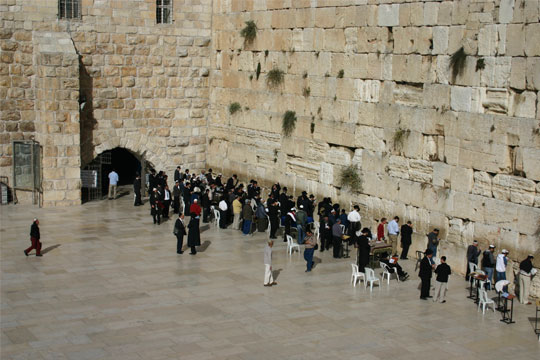
Living in the Boston suburbs, my students have the privilege of regularly visiting many of our nation’s important historical sites. As much of a blessing as this is, it also makes it more difficult for them to conceptualize the setting of the important events in their faith heritage. I have been challenged by the task of finding ways of making Jesus’ life come alive for my students from the confines of our parish hall. The following activity is designed to help your students learn about Jerusalem and make associations between a city Christ knew and their own.
Before teaching this lesson, you’ll need to make time for a little adventure of your own. Drive around the town where your students live and take pictures of important places, such as a grocery store, town hall, Main Street, your church, a cemetery, a district court, library, and others. Then search the Web for copyright-free pictures of buildings with a similar function in ancient Jerusalem, such as a market place, Herod’s Temple, Herod’s Palace, and Calvary. Arrange the pictures of both ancient and modern buildings in a slideshow. If you know of a parishioner who recently completed a pilgrimage to Jerusalem, you can ask to use some of his or her pictures for a more personal touch. This person may even be interested in coming in as a guest speaker to share some anecdotes of his or her experiences in Jerusalem.
When you are assembled with your students, begin by having them draw a map of their neighborhood or town. Encourage students to draw their house, important landmarks, and places where they spend lots of time. Gather students together and allow them to share their maps with one another. Ask them to share a story (just one) about their favorite place in their town with the group. Once all of the willing students have shared their maps, remind your students that Jesus lived in a town similar to theirs. Display a large map of Jerusalem; this could either be on a poster or a larger model. Point out important landmarks that Jesus may have included in his own depiction of his neighborhood.
These places will seem more real when students can see what they actually look like. Share your slideshow containing pictures of places in Jerusalem and your town. Discuss each place as it comes up, inviting students to share a fact about the place in their town on the slide, and then telling a little bit about the similar place in Jerusalem. Point out where each place is on the map of Jerusalem, and color it in if you are able. Share stories of Jesus in Jerusalem from Scripture, and make them more relatable by comparing them to activities in your students’ lives. Add colorful commentary to help students feel even more familiar with the city Jesus knew so intimately. By the end of your slideshow, you’ll have colored in a good portion of the map, showing students that they know about lots of the city without even leaving their seats.
Close the lesson with a review game. Have all students stand in a straight line in the middle of the room and ask them a series of questions about Jerusalem, each with two possible answers (for example, Were the books kept in the palace or the Temple? Did Jesus die on the cross in the Garden of Gethsemane or at Calvary?). Allow students a moment to think about their response and then hold up one or two fingers to show which answer they’re choosing. For each question the student gets right, he or she takes a step forward. For each question answered incorrectly, the student takes a step backwards. The winning student is the one who is closest to the front of the room after your round of questions is completed. As a prize the winner can choose the class’s closing prayer. (If you’re more fun than I, you may want to offer a prize such as a piece of candy!)
Even though you can’t take a field trip to Jerusalem, your students will feel more comfortable with the city by forming so many associations between Jerusalem and their own hometown. As our students grow in familiarity with Jesus’ life, they will grow in relationship with him. As your class closes in prayer, remind students to pray in thanksgiving that we can experience so many of the same things as Jesus did and learn to live like he did in everything we have in common with him.
How do you help the students in your class connect their lived experiences with those of Jesus?



Leave a Reply